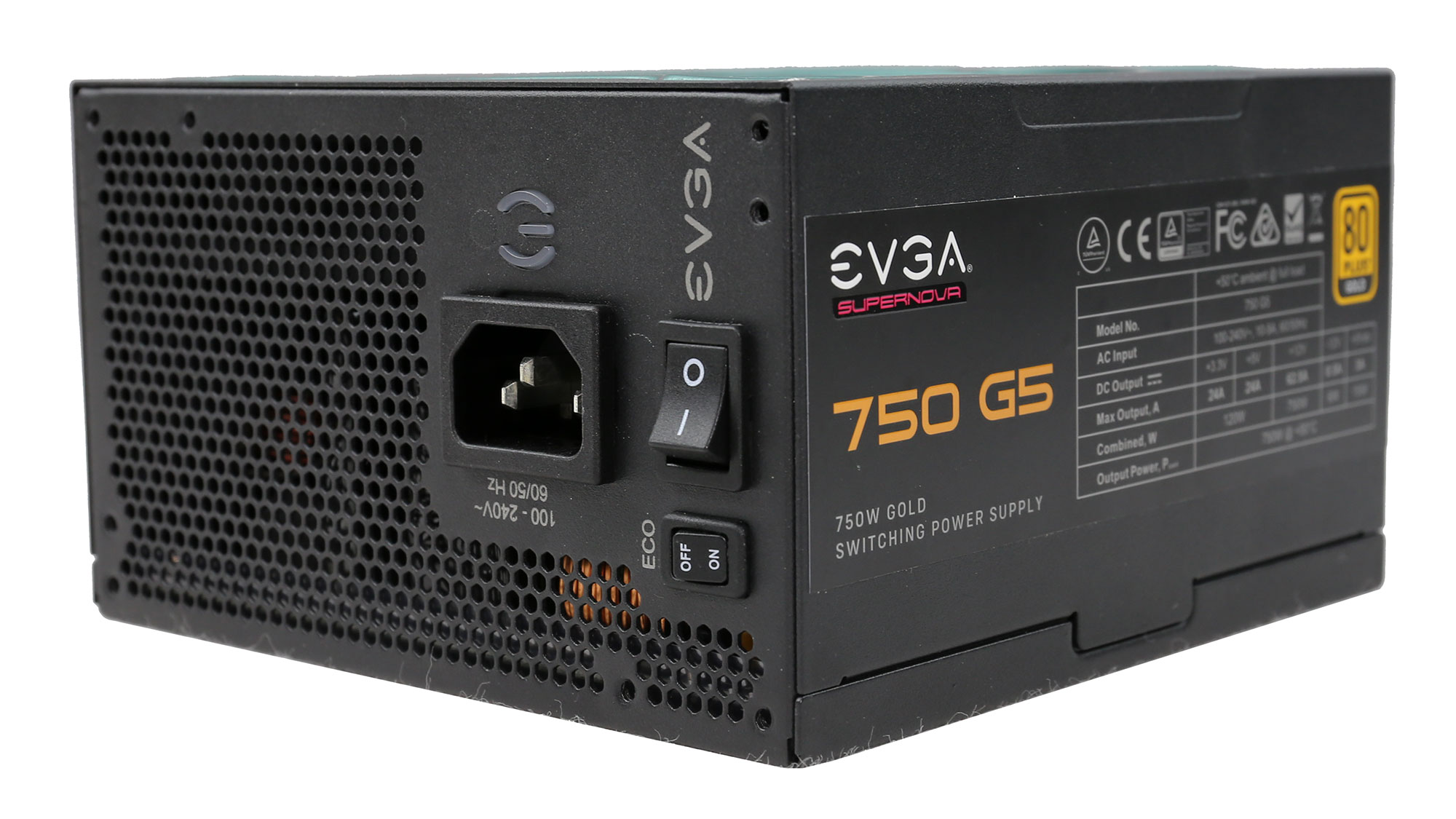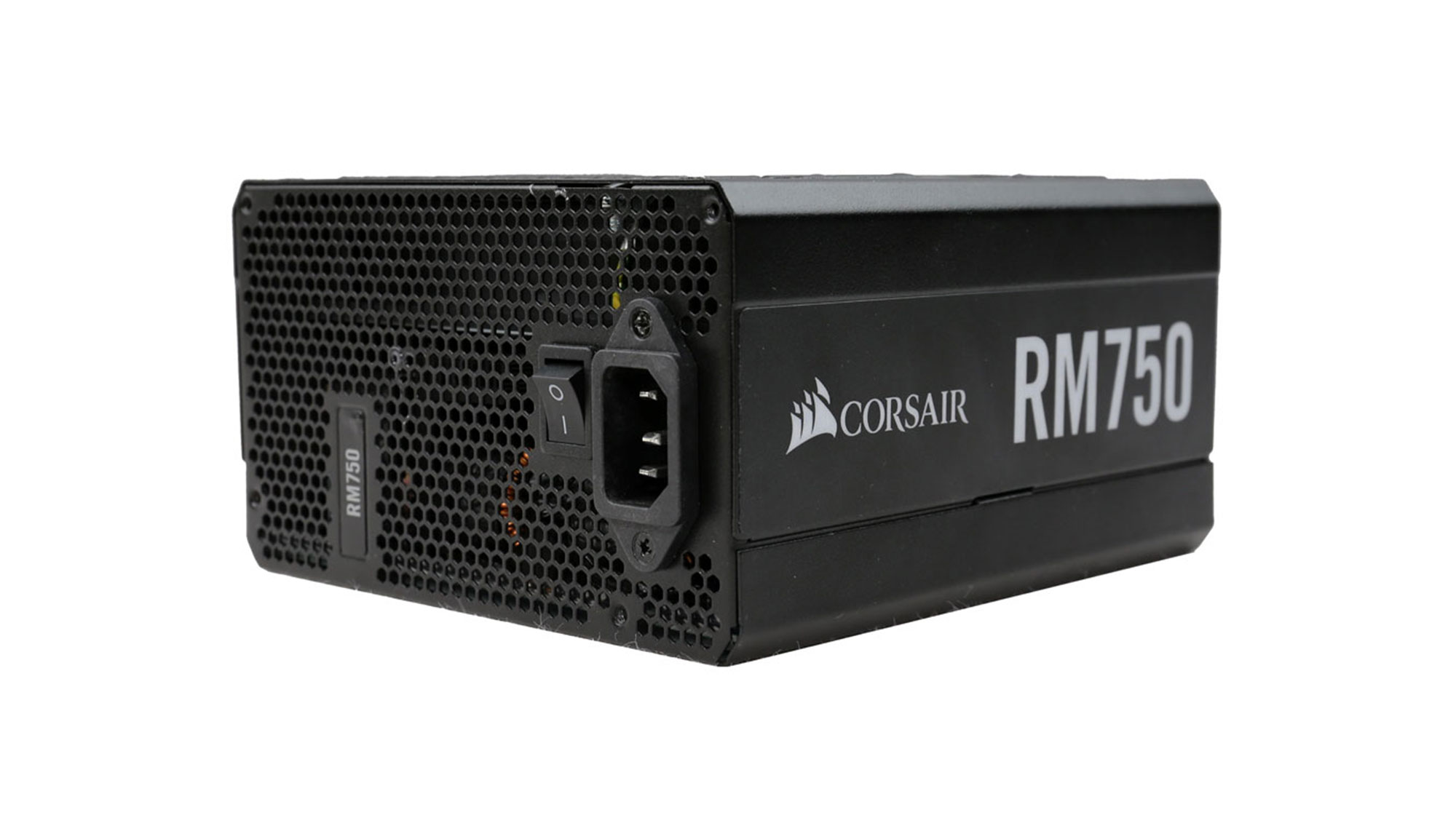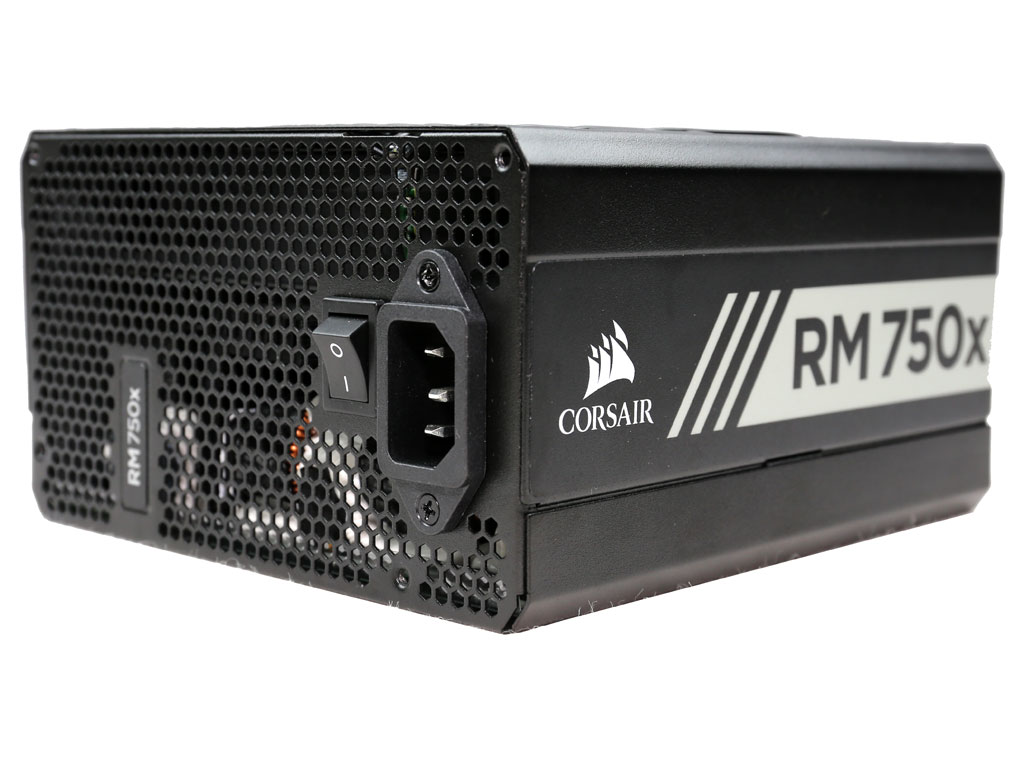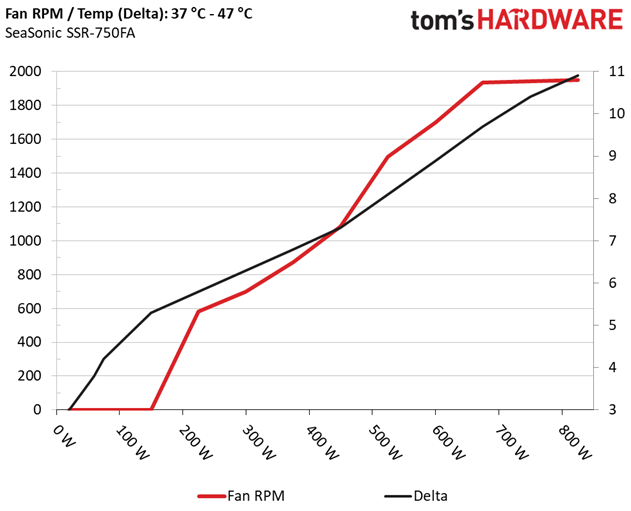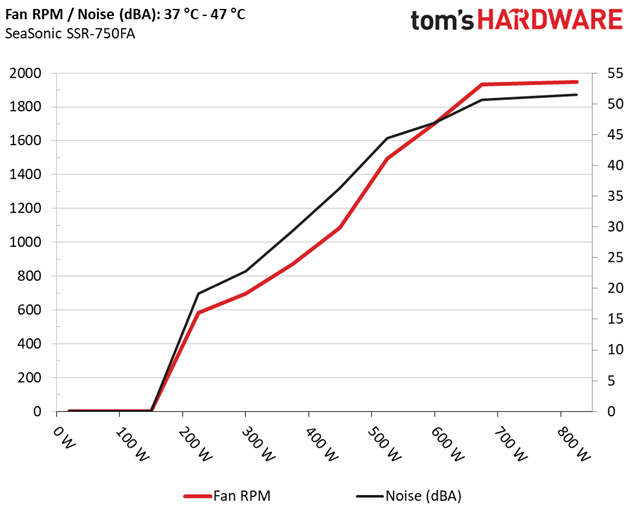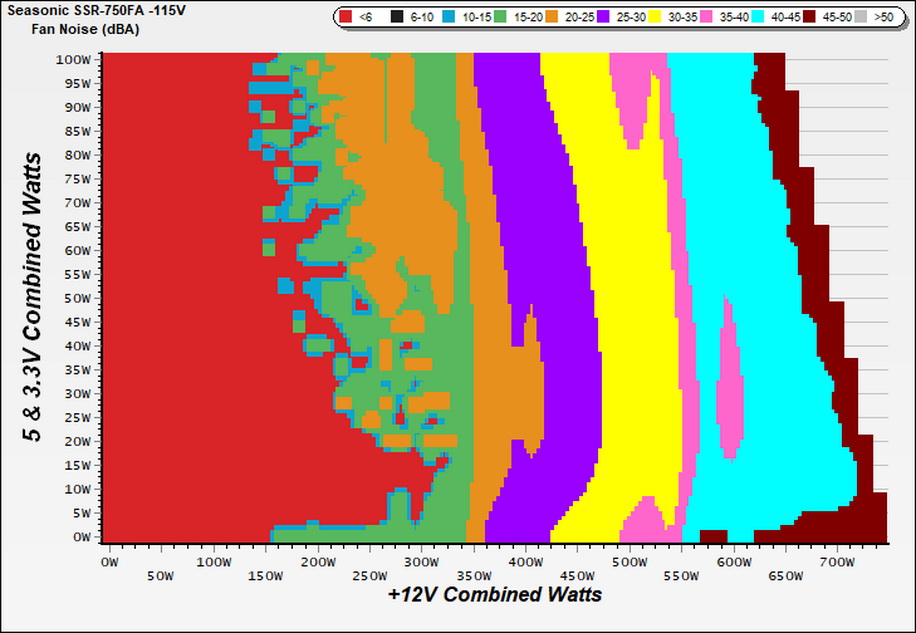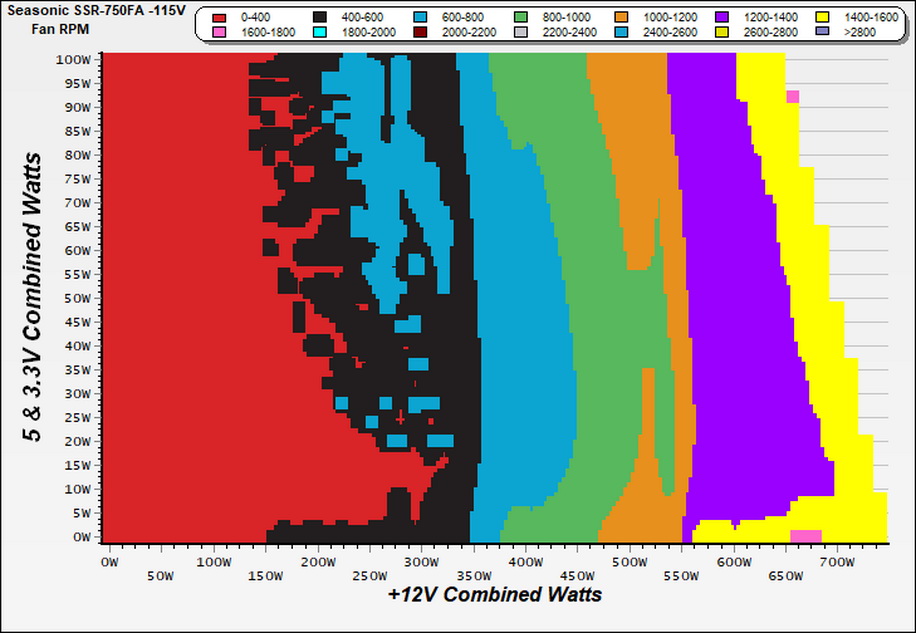Why you can trust Tom's Hardware
To learn more about our PSU tests and methodology, please check out How We Test Power Supply Units.
Primary Rails And 5VSB Load Regulation
The following charts show the main rails' voltage values recorded between a range of 40W up to the PSU's maximum specified load, along with the deviation (in percent). Tight regulation is an important consideration every time we review a power supply because it facilitates constant voltage levels despite varying loads. Tight load regulation also, among other factors, improves the system’s stability, especially under overclocked conditions and, at the same time, it applies less stress to the DC-DC converters that many system components utilize.
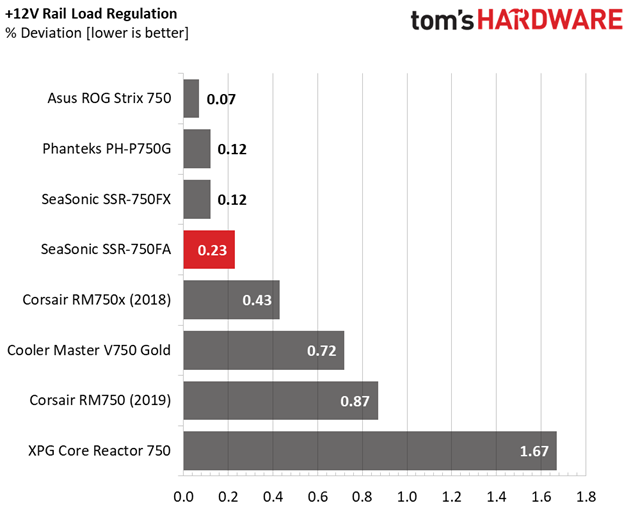
Results 1-8: Load Regulation

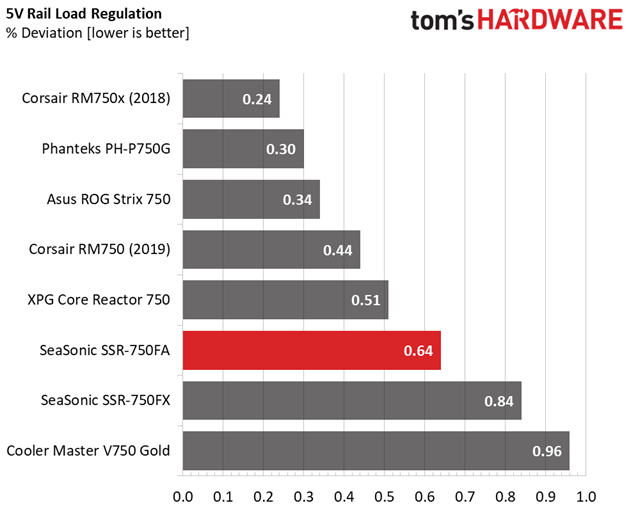
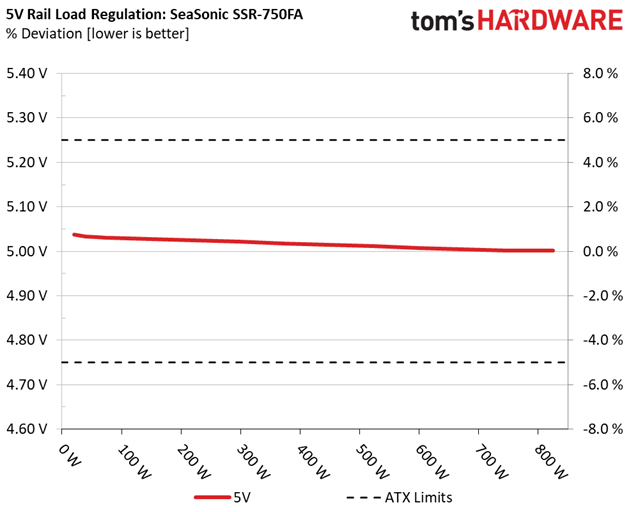
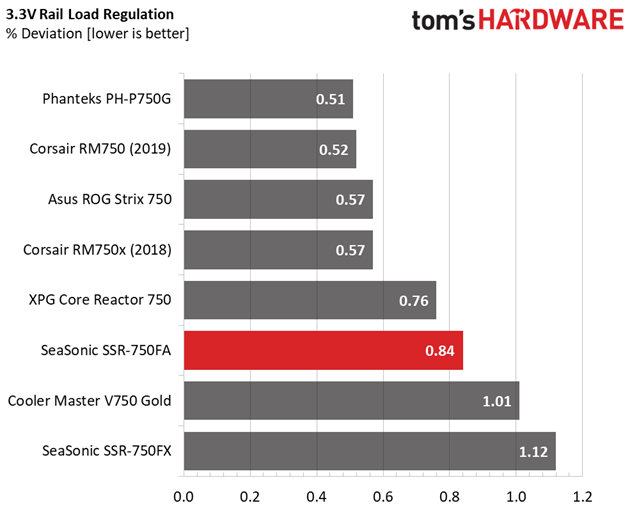
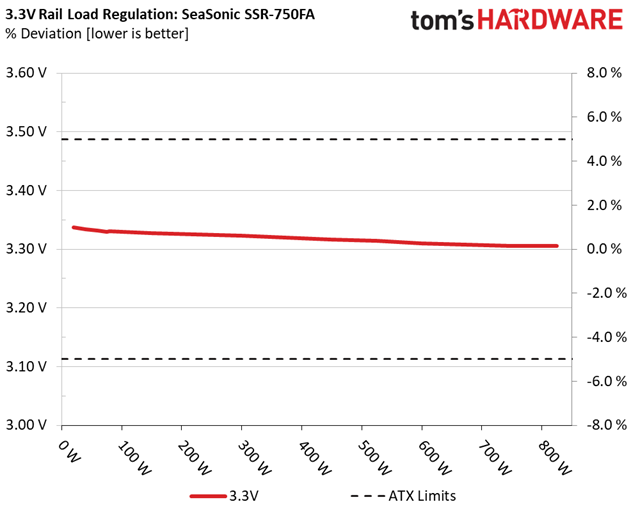
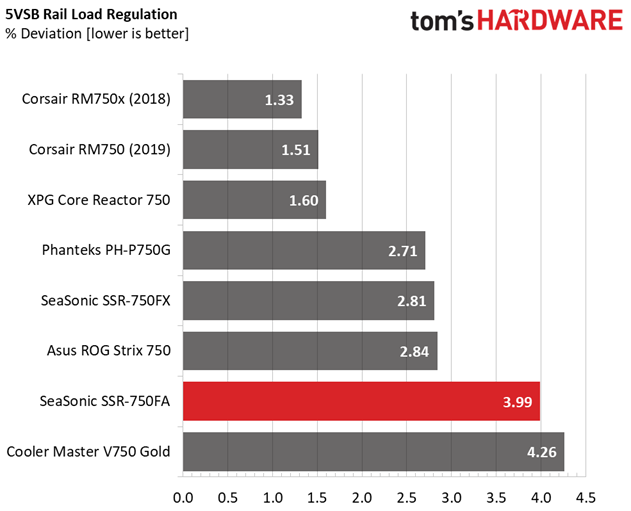
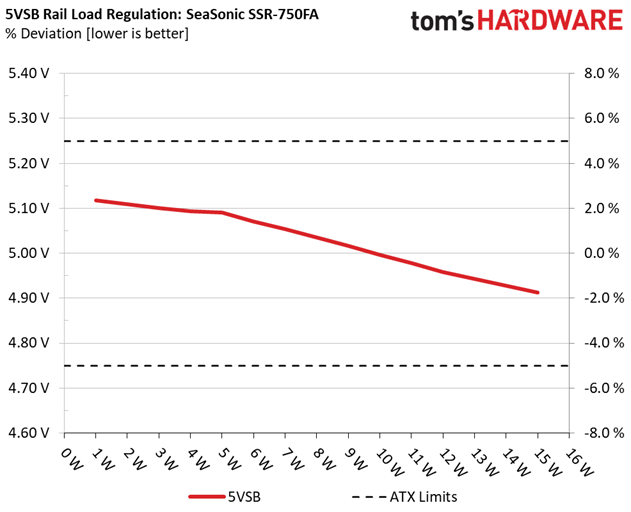
The load regulation is pretty tight on all rails. Compared to the Focus Plus Gold unit, it loses at +12V and 5VSB but wins on the minor rails. This is because of the Connect module, which might only be a link for +12V and 5VSB, but generates the minor rails, so the energy losses are lower.
Hold-Up Time
Put simply; hold-up time is the amount of time that the system can continue to run without shutting down or rebooting during a power interruption.
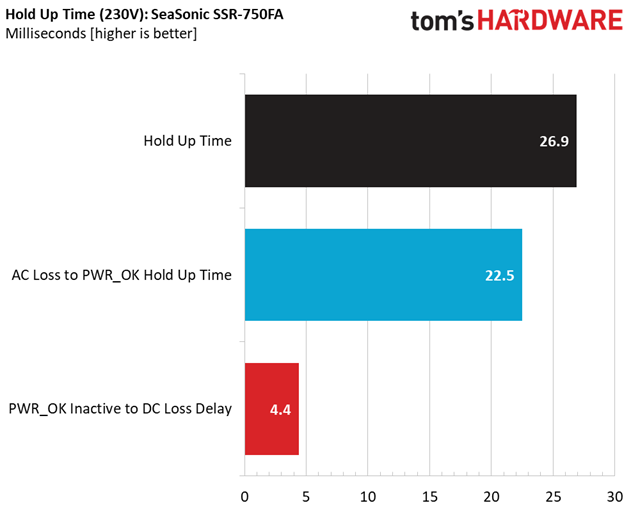
Results 9-12: Hold-Up Time
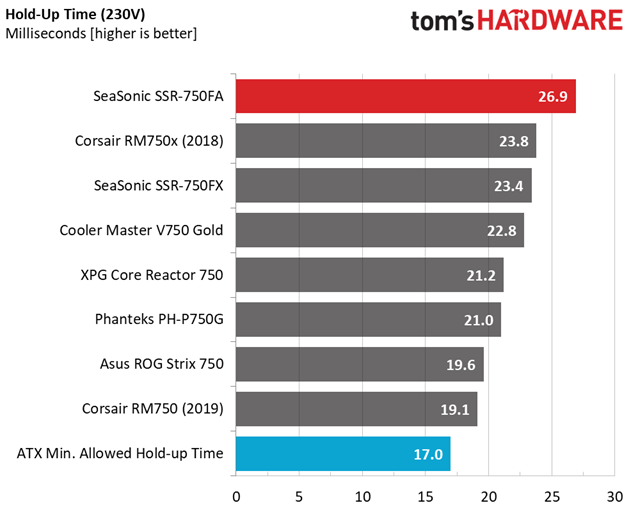
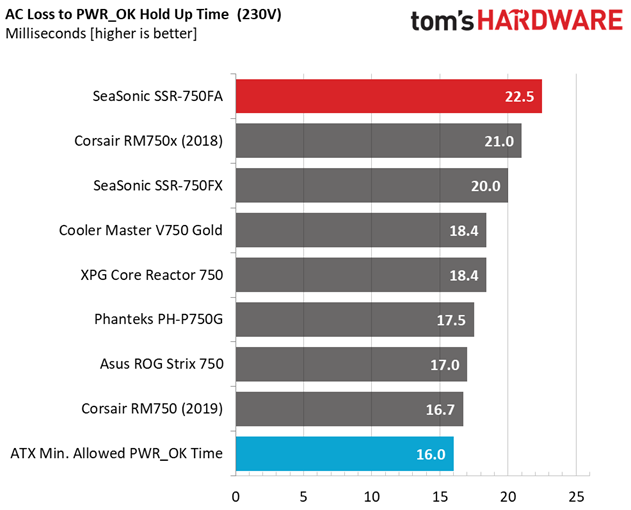
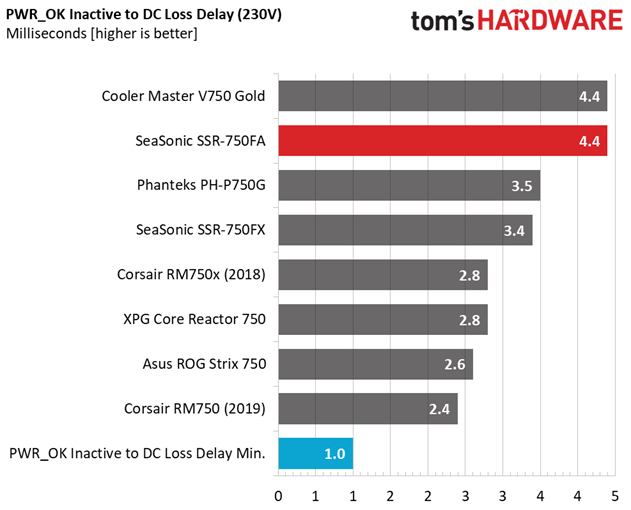
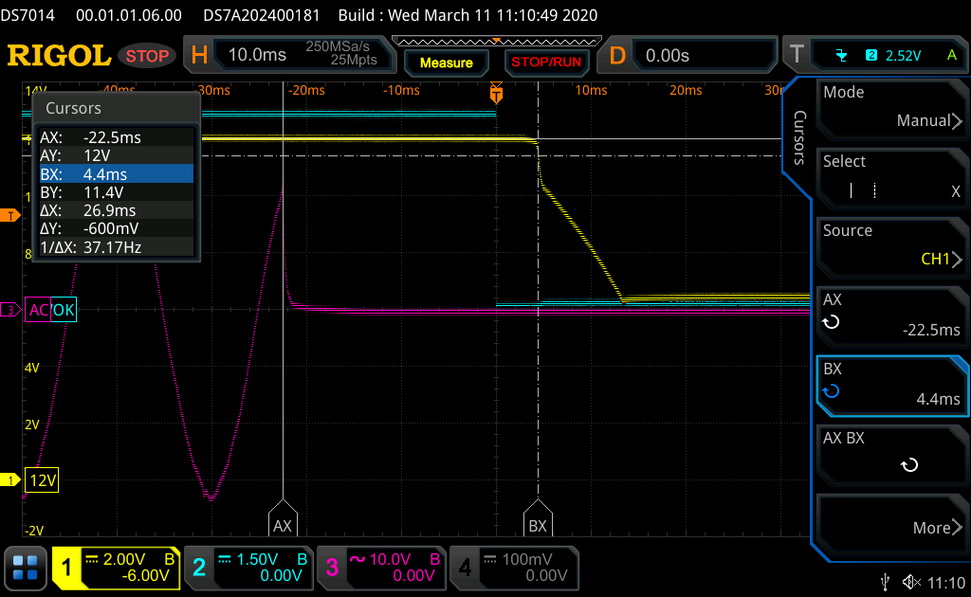
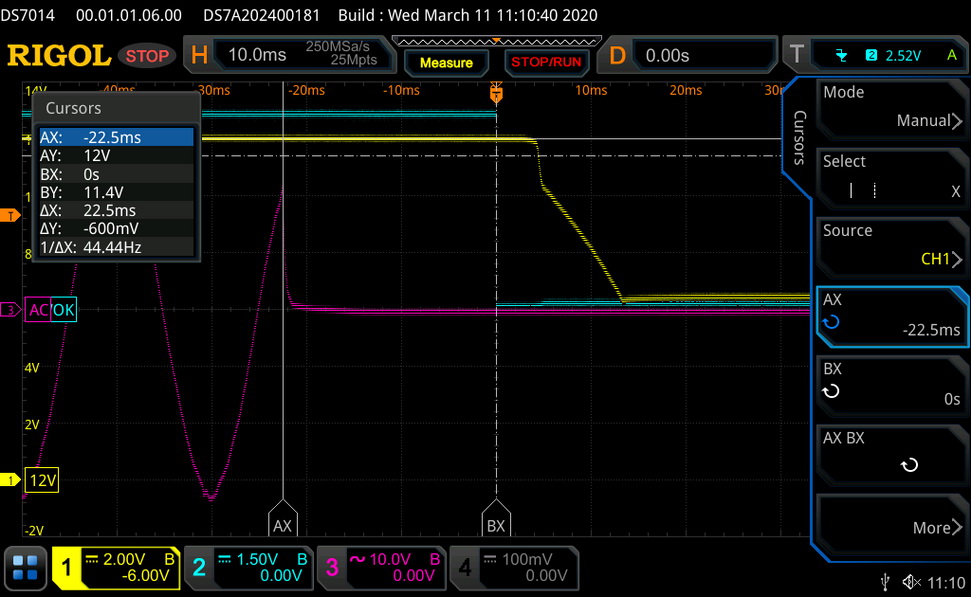
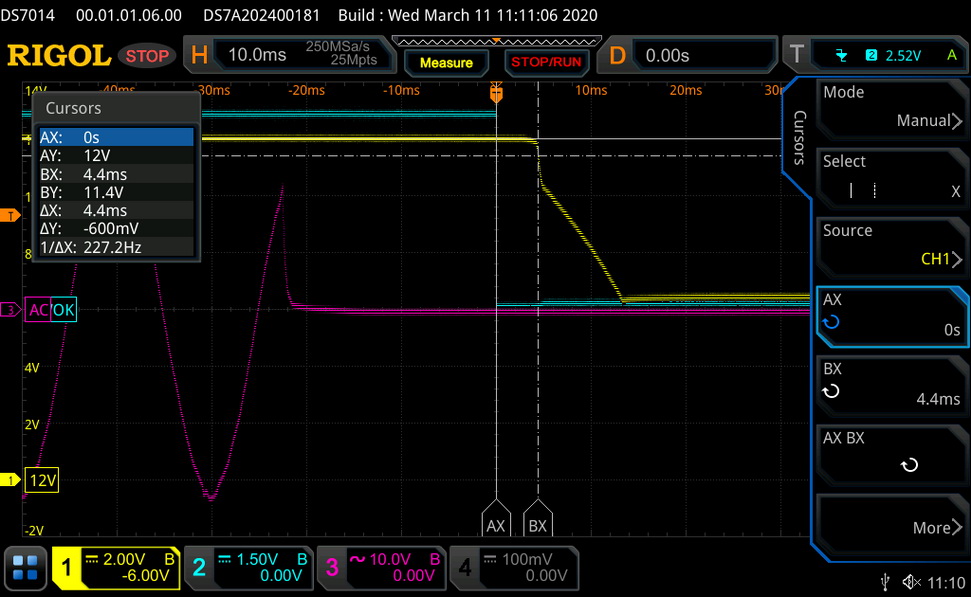
The hold-up time is much longer than 17ms, which is what the ATX spec requires, and the power ok signal is accurate.
Inrush Current
Inrush current, or switch-on surge, refers to the maximum, instantaneous input current drawn by an electrical device when it is first turned on. A large enough inrush current can cause circuit breakers and fuses to trip. It can also damage switches, relays, and bridge rectifiers. As a result, the lower the inrush current of a PSU right as it is turned on, the better.
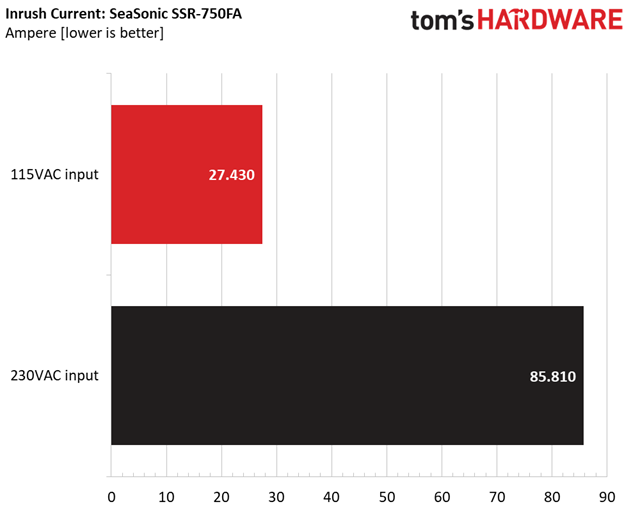
Results 13-14: Inrush Current
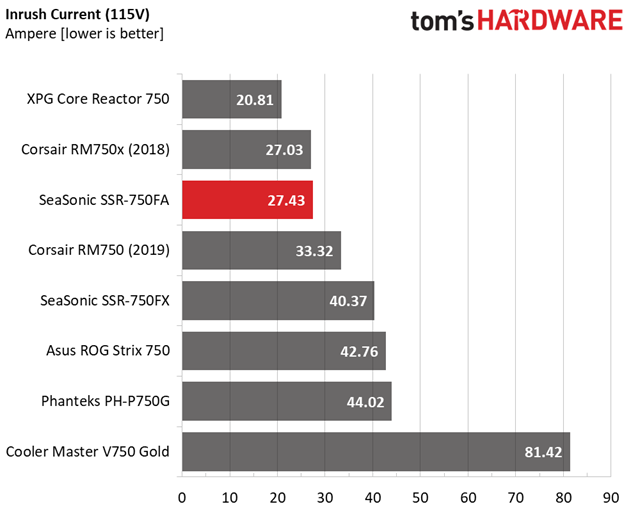
With 115V input the inrush current is low, but this is not the case with 230V.
Get Tom's Hardware's best news and in-depth reviews, straight to your inbox.
10-110% Load Tests
These tests reveal the PSU's load regulation and efficiency levels under high ambient temperatures. They also show how the fan speed profile behaves under increased operating temperatures.
| Test # | 12V | 5V | 3.3V | 5VSB | D°C/A°C (Watts) | Effi°Cien°Cy | Fan Speed (RPM) | PSU Noise (dB[A]) | Temps (In/Out) | PF/A°C Volts |
| 1 | 4.424A | 1.989A | 1.982A | 0.983A | 74.957 | 85.471% | 0 | <6.0 | 45.55°C | 0.968 |
| 12.059V | 5.030V | 3.330V | 5.090V | 87.699 | 40.57°C | 115.14V | ||||
| 2 | 9.880A | 2.985A | 2.974A | 1.184A | 150.026 | 89.140% | 0 | <6.0 | 46.54°C | 0.981 |
| 12.057V | 5.027V | 3.327V | 5.070V | 168.304 | 41.24°C | 115.11V | ||||
| 3 | 15.677A | 3.484A | 3.474A | 1.385A | 225.025 | 90.141% | 582 | 19.2 | 41.65°C | 0.987 |
| 12.054V | 5.024V | 3.325V | 5.053V | 249.638 | 47.43°C | 115.11V | ||||
| 4 | 21.475A | 3.984A | 3.974A | 1.589A | 300.031 | 90.068% | 698 | 22.8 | 41.96°C | 0.988 |
| 12.052V | 5.022V | 3.323V | 5.035V | 333.117 | 48.23°C | 115.11V | ||||
| 5 | 26.892A | 4.984A | 4.969A | 1.794A | 374.529 | 89.751% | 872 | 29.3 | 42.61°C | 0.988 |
| 12.049V | 5.018V | 3.320V | 5.017V | 417.297 | 49.38°C | 115.10V | ||||
| 6 | 32.350A | 5.984A | 5.970A | 2.000A | 449.457 | 89.244% | 1086 | 36.3 | 42.72°C | 0.988 |
| 12.045V | 5.014V | 3.317V | 4.997V | 503.626 | 50.03°C | 115.09V | ||||
| 7 | 37.842A | 6.983A | 6.972A | 2.210A | 524.792 | 88.532% | 1495 | 44.4 | 43.14°C | 0.988 |
| 12.042V | 5.011V | 3.314V | 4.978V | 592.774 | 51.27°C | 115.08V | ||||
| 8 | 43.334A | 7.991A | 7.976A | 2.421A | 600.112 | 87.773% | 1701 | 46.9 | 43.72°C | 0.989 |
| 12.039V | 5.007V | 3.310V | 4.958V | 683.712 | 52.62°C | 115.07V | ||||
| 9 | 49.199A | 8.494A | 8.464A | 2.428A | 674.613 | 87.075% | 1934 | 50.7 | 45.01°C | 0.990 |
| 12.035V | 5.004V | 3.308V | 4.943V | 774.747 | 54.67°C | 115.07V | ||||
| 10 | 54.861A | 8.997A | 8.983A | 3.054A | 749.847 | 86.308% | 1941 | 51.1 | 45.21°C | 0.991 |
| 12.033V | 5.002V | 3.306V | 4.913V | 868.799 | 55.62°C | 115.06V | ||||
| 11 | 61.122A | 8.999A | 8.984A | 3.063A | 825.067 | 85.553% | 1949 | 51.5 | 46.50°C | 0.992 |
| 12.031V | 5.001V | 3.306V | 4.898V | 964.397 | 57.39°C | 115.05V | ||||
| °CL1 | 0.116A | 11.999A | 12.000A | 0.000A | 101.052 | 84.152% | 584 | 19.2 | 42.42°C | 0.977 |
| 12.049V | 5.006V | 3.299V | 5.097V | 120.082 | 49.15°C | 115.12V | ||||
| °CL2 | 62.005A | 1.000A | 1.001A | 1.000A | 759.994 | 86.960% | 1943 | 51.2 | 45.78°C | 0.991 |
| 12.042V | 5.023V | 3.333V | 4.971V | 873.959 | 55.99°C | 115.04V |
With 30% load, the PSU achieves its peak efficiency, which is a little over 90%. With full load, efficiency takes a hit and cannot reach close to 87%, as the 80 PLUS Gold standard requires. Nonetheless, we conducted these tests at much higher operating temperatures, compared to 80 PLUS. Finally, the PF readings are not as high as we would like to see, especially at lower loads.
20-80W Load Tests
In the following tests, we measure the PSU's efficiency at loads significantly lower than 10% of its maximum capacity (the lowest load the 80 PLUS standard measures). This is important for representing when a PC is idle with power-saving features turned on.
| Test # | 12V | 5V | 3.3V | 5VSB | DC/AC (Watts) | Efficiency | Fan Speed (RPM) | PSU Noise (dB[A]) | PF/AC Volts |
| 1 | 1.231A | 0.496A | 0.494A | 0.195A | 19.992 | 69.371% | 0 | <6.0 | 0.860 |
| 12.062V | 5.037V | 3.337V | 5.117V | 28.819 | 115.14V | ||||
| 2 | 2.461A | 0.993A | 0.989A | 0.392A | 39.980 | 79.764% | 0 | <6.0 | 0.935 |
| 12.061V | 5.034V | 3.334V | 5.109V | 50.123 | 115.14V | ||||
| 3 | 3.694A | 1.492A | 1.486A | 0.588A | 60.008 | 83.966% | 0 | <6.0 | 0.958 |
| 12.060V | 5.032V | 3.332V | 5.101V | 71.467 | 115.14V | ||||
| 4 | 4.922A | 1.989A | 1.980A | 0.786A | 79.957 | 86.147% | 0 | <6.0 | 0.970 |
| 12.059V | 5.030V | 3.331V | 5.093V | 92.815 | 115.14V |
We would like to see over 70% efficiency with 20W load, and above 80% with 40W.
2% or 10W Load Test
Intel plans on raising the ante at efficiency levels under ultra-light loads. So from July 2020, the ATX spec will require 70% and higher efficiency with 115V input. The applied load is only 10W for PSUs with 500W and lower capacities, while for stronger units we dial 2% of their max-rated-capacity.
| Test # | 12V | 5V | 3.3V | 5VSB | DC/AC (Watts) | Efficiency | Fan Speed (RPM) | PSU Noise (dB[A]) | PF/AC Volts |
| 1 | 1.080A | 0.209A | 0.211A | 0.052A | 15.043 | 61.248% | 0 | <6.0 | 0.824 |
| 12.056V | 5.037V | 3.338V | 5.118V | 24.561 | 115.15V |
With 2% of the max-rated-capacity load, the PSU's efficiency is quite low, barely exceeding 60%. In newer designs, even under such a light load, efficiency easily breaks the 70% mark.
Efficiency
Next, we plotted a chart showing the PSU’s efficiency at low loads, and loads from 10 to 110% of its maximum rated capacity. The higher a PSU’s efficiency, the less energy goes wasted, leading to a reduced carbon footprint and lower electricity bills.
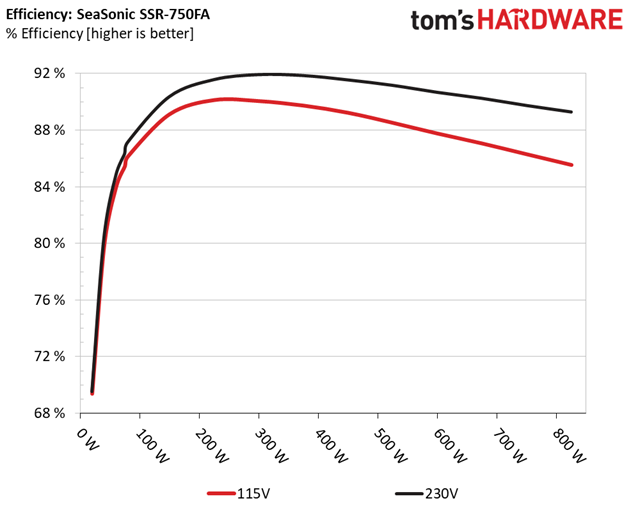
Results 15-18: Efficiency
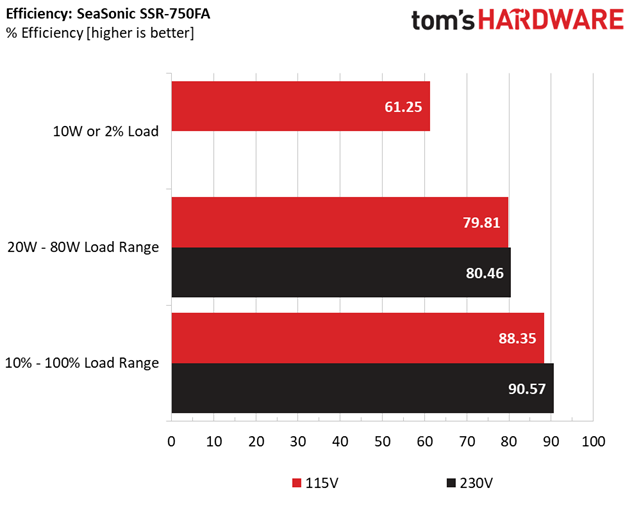
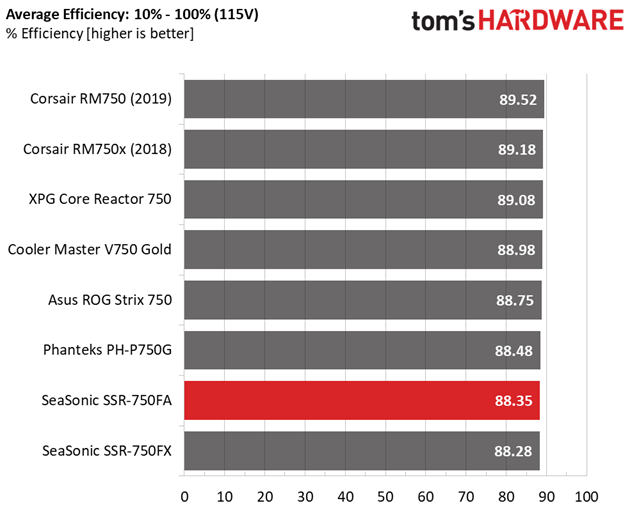
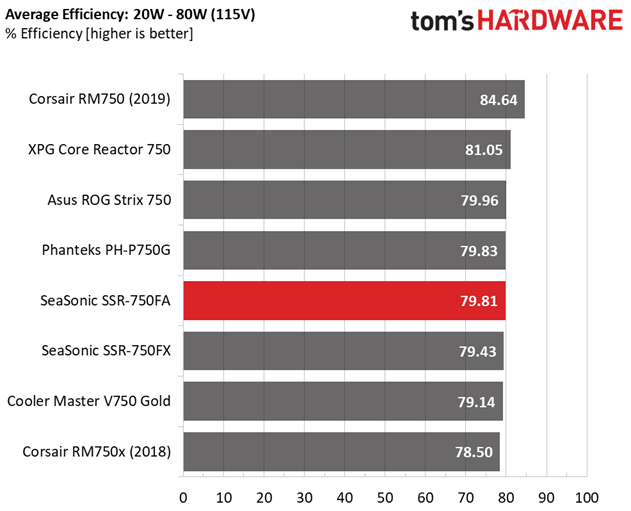
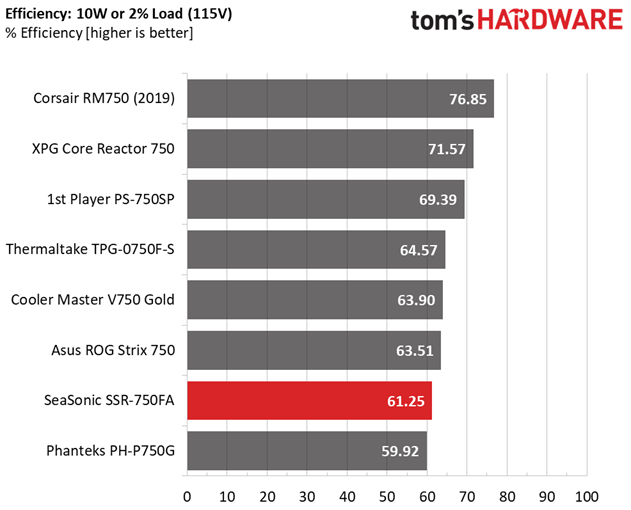
With normal and 2% loads, the efficiency levels are not that high, compared to the competition at least, while with light loads, the PSU's efficiency is satisfactory.
5VSB Efficiency
| Test # | 5VSB | DC/AC (Watts) | Efficiency | PF/AC Volts |
| 1 | 0.100A | 0.512 | 73.988% | 0.108 |
| 5.121V | 0.692 | 115.15V | ||
| 2 | 0.250A | 1.280 | 76.236% | 0.223 |
| 5.117V | 1.679 | 115.15V | ||
| 3 | 0.550A | 2.811 | 77.077% | 0.340 |
| 5.110V | 3.647 | 115.14V | ||
| 4 | 1.000A | 5.100 | 76.669% | 0.413 |
| 5.099V | 6.652 | 115.14V | ||
| 5 | 1.500A | 7.633 | 76.891% | 0.451 |
| 5.088V | 9.927 | 115.14V | ||
| 6 | 3.000A | 15.137 | 74.394% | 0.505 |
| 5.045V | 20.347 | 115.12V |
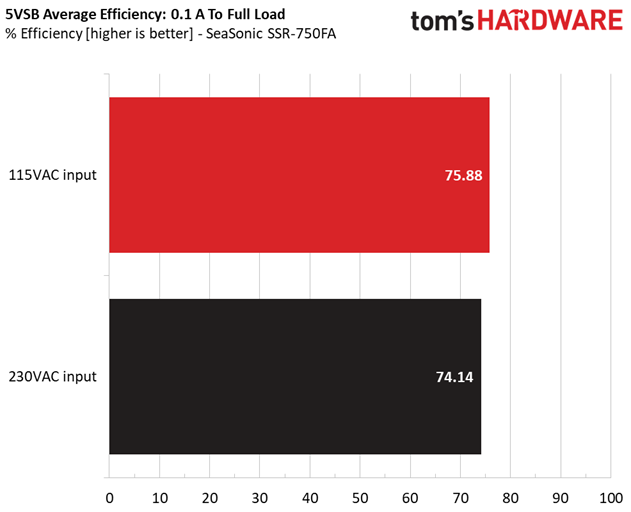
Results 19-20: 5VSB Efficiency
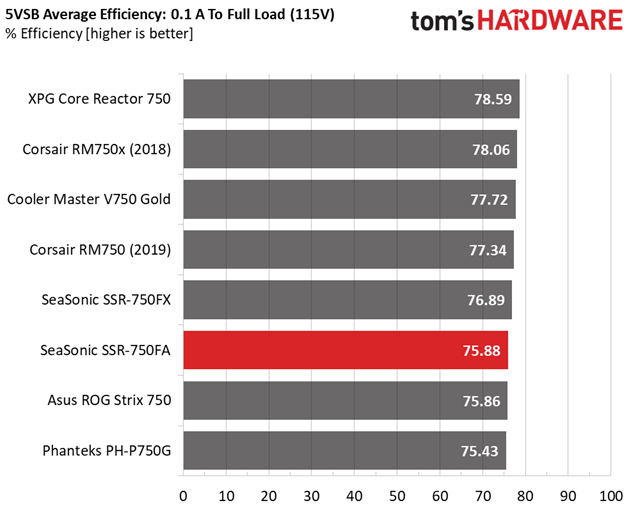
The 5VSB rail needs an efficiency boost, to effectively meet the competition. This can only be achieved through a new design, of course.
Power Consumption In Idle And Standby
| Mode | 12V | 5V | 3.3V | 5VSB | Watts | PF/AC Volts |
| Idle | 12.056V | 5.037V | 3.338V | 5.121V | 9.867 | 0.547 |
| 115.1V | ||||||
| Standby | 0.043 | 0.007 | ||||
| 115.1V |
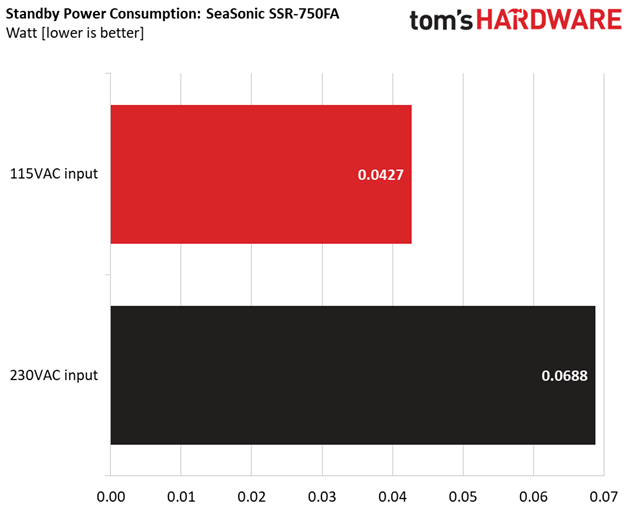
Results 21-22: Vampire Power
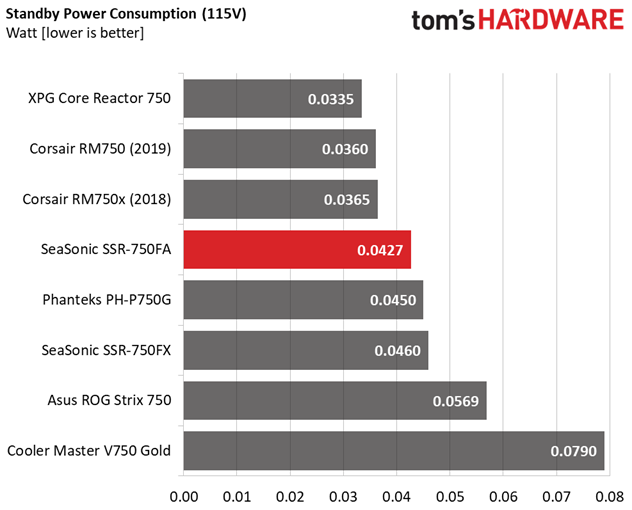
The vampire power levels are low, with both voltage inputs.
Fan RPM, Delta Temperature, And Output Noise
All results are obtained between an ambient temperature of 37 to 47 degrees Celsius (98.6 to 116.6 degrees Fahrenheit).
The fan profile is aggressive, especially under high operating temperatures and increased loads.
The following results were obtained at 30 to 32 degrees Celsius (86 to 89.6 degrees Fahrenheit) ambient temperature.
The fan speed profile remains aggressive under normal operating temperatures. Given the ample space between components in this PSU and the satisfactory efficiency levels, there is no need for such high fan speeds.
MORE: Best Power Supplies
MORE: How We Test Power Supplies
MORE: All Power Supply Content
Current page: Load Regulation, Hold-Up Time, Inrush Current, Efficiency and Noise
Prev Page Specifications and Part Analysis Next Page Protection Features, DC Power Sequencing, Cross-Load Tests and Infrared Images
Aris Mpitziopoulos is a contributing editor at Tom's Hardware, covering PSUs.
-
Math Geek i missed this one some how before it was released. but i like the idea and do hope we get more and more of these. is a solution to something i never even thought of as a problem, but now can't imagine doing without!!Reply -
bit_user Thanks for the thorough and comprehensive review, Aris!Reply
I don't have a problem with their existing modular setup. I have 3 Seasonic modular PSUs (and one semi-modular) and have swapped two of them between machines, on a couple occasions. It was very nice to be able to swap PSUs without having to unplug, reroute, and reconnect the cables from everything - just disconnect them at the PSU end. I also like being able to borrow cables that came with one PSU to use with another.
With that said, I would use this style of setup under two conditions:
Actual PSU performance should equal or exceed their conventional models.
Cable compatibility should be retained with their existing modular PSUs.
Otherwise, I'll just stick with what's been working just fine for me, as long as they continue to be available.
